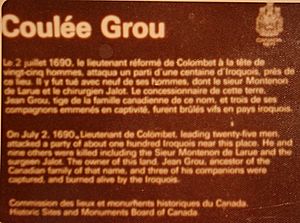Coulée Grou facts for kids
Coulée Grou is a special place in Montreal, Quebec, Canada. It's known for a big battle that happened there long ago during a time called the Beaver Wars. These wars are also known as the Iroquois Wars. The area was named after Jean Grou, an early Canadian pioneer. Jean Grou sailed from Rouen in France around 1650-1665 when he was a young boy. He settled in a place called Rivière-des-Prairies–Pointe-aux-Trembles, which is east of modern-day Montreal. On July 2, 1690, a battle took place here where Jean Grou and three farm workers were captured and tragically killed.
Contents
What is Coulée Grou?
Coulée Grou is more than just a place; it's a National Historic Site of Canada. This means it's a very important spot in Canadian history. It was given this special title in 1924. The Historic Sites and Monuments Board placed a monument there to remember the battle between French soldiers and the native Iroquois people.
The Battle of 1690
The monument at Coulée Grou helps us remember a difficult day in history. On July 2, 1690, a group of about 25 French soldiers, led by Lieutenant de Colombet, faced a much larger group of about 100 Iroquois warriors. Many people were killed in this fight. Lieutenant de Colombet and nine others lost their lives, including Sieur Montenon de Larue and the surgeon Jalot.
Who Was Jean Grou?
Jean Grou, who owned the land where the battle happened, was also captured during this attack. He and three of his friends were killed by the Iroquois. Jean Grou is an important ancestor of many Canadian families who still carry the Grou name today. Joseph Lajeunesse, one of Jean Grou's descendants, later donated the land and stone for the monument we see there now.
Remembering the Battle
A very old record from November 2, 1694, tells us more about this battle. It explains that the Iroquois killed several people near Jean Grou's "coulee" (a small valley or ravine). Some of the captured, like Pierre Payet dit St-Amours, were held prisoner but later returned. Because the Iroquois were greatly feared, the bodies of those killed were quickly buried right where they fell. It wasn't until November 2, 1694, that their bones were moved to the cemetery and properly buried.
Why is Coulée Grou Important Today?
The history of Coulée Grou and Jean Grou lives on in different ways. It reminds us of the early days of New France and the conflicts that shaped the country.
The HMCS Grou Ship
Did you know that a Canadian Navy ship was named after Jean Grou? The frigate HMCS Grou was an attack ship. It was named in honor of Jean Grou by the Canadian National Defence. This shows how important Jean Grou's story is to Canada's history.
The Grou Family Legacy
Many people in North America with surnames like Groux, Groulx, or La Grou can trace their family back to Jean Grou. One famous person from this family was Lionel Groulx. He was a well-known historian from Quebec and a strong supporter of Quebec nationalism. He is even called the "spiritual father of modern Quebec" by some, like Claude Ryan. This means he greatly influenced how people thought about Quebec's identity and future.


